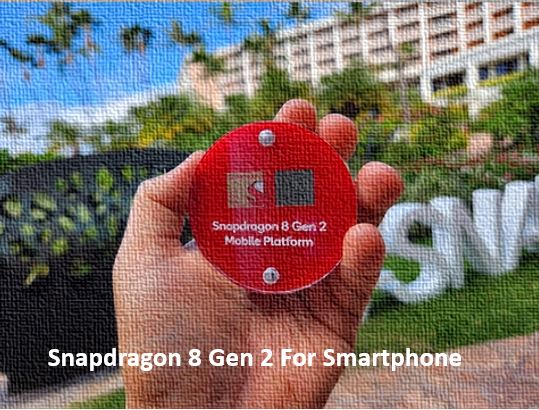Table of Contents
Qualcomm flagship SoC A model with Snapdragon 8 Gen 2 will be released at the end of the year
Qualcomm is holding a Snapdragon Summit in Hawaii, USA for three days from 15th to 17th. A keynote speech will be held on the 15th, the first day. Announced “Snapdragon 8 Gen 2”.
The Snapdragon 8 series is a chipset used in high-end models. At last year’s event, the naming rules were revised, and the generation was added after the single-digit number that represents performance. The Snapdragon 8 Gen 2 is its second generation chipset.
The biggest feature in Snapdragon 8 Gen 2
The biggest feature is that the DSP (Digital Signal Processor) Hexagon has been strengthened to improve AI performance. The AI function named “Snapdragon Smart” has achieved a speedup of up to 4.35 times overall.
For the first time, it supports “INT4” (a mechanism that performs integer arithmetic with 4 bits to reduce processing weight), which enables inference by high-speed processing.
The performance per power consumption has improved by 60%.
Enhanced inference improves natural language processing capabilities. It makes it easier to implement applications such as real-time transcription and translation.
At the event, a video showed Xiaomi using this function to perform real-time translation on the device. The person in charge said, “Even with Xiaomi’s new flagship smartphone, we would like to take advantage of the potential of the platform.” Likely.
The enhanced Hexagon also works with an ISP (Image Signal Processor) that processes camera footage. Support real-time semantic segmentation by leveraging AI.
Semantic means “meaning”. By dividing the subject according to its role and applying the optimum processing to each, the finish of the photograph is improved. For example, separating a person from a landscape, or separating eyes, skin, and hair in a face.
According to a Qualcomm product manager, “the sky can be bluer and the grass greener.”
However, after decomposing a photo into each element, various smartphones are equipped with a function that performs optimal processing.
In fact, not only the iPhone, which uses the Neural Engine in the chipset, but also the Pixel series, which has Tensor, incorporates this processing method.
Snapdragon 8 Gen 2’s semantic segmentation is strong in that it performs its processing in real time. That’s why it supports video recording.
In addition to the ISP itself, we are also strengthening cooperation with sensors. At last year’s event, it announced the establishment of a joint venture with Qualcomm and Sony Semiconductor Solutions, the result of which has been incorporated into the Snapdragon 8 Gen 2. Specifically, Sony’s “IMX 800” (1/1.5 inch) and “IMX 989” (1 inch) are optimized for Snapdragon.
It corresponds to a new HDR called “Quad Digital Overlap HDR”, which synthesizes a total of 4 photos, 2 photos each shifted in space and time.
According to Mr. Michiki Mikuriya, Deputy General Manager of Mobile System Division, Sony Semiconductor Solutions, who took the stage at the event after the keynote speech, it is possible to reduce noise due to synthesis more than conventional HDR.
In addition, as a result of “optimization at the system level” with Qualcomm, low power consumption of zooming by camera switching is realized. We made this possible by keeping the camera idle at a low frame rate when not in use.
Cameras aren’t the only things that use AI. The modem “Snapdragon X70 5G” integrated into the Snapdragon 8 Gen 2 has also improved its performance with AI.
The modem was announced in conjunction with MWC Barcelona held in Barcelona, Spain in February. It is characterized by the ability to improve throughput by optimizing propagation path information with AI.
In addition, since it becomes possible to stably pick up radio waves with weaker electric field strength, the effect of expanding the area can also be obtained.
In terms of specifications, it supports dual connectivity (DC) and achieves a maximum downlink speed of 10 Gbps with a combination of millimeter waves and Sub 6. Uplink DC is also possible, and the theoretical value here is a maximum of 3.5 Gbps. It also supports 5G-5G and 5G-4G DSDA (dual SIM/dual active).
A new feature in Snapdragon 8 Gen 2
A new feature that I would like to pay attention to in gaming is the real-time ray tracing adopted by the GPU “Adreno”. By simulating the refraction and reflection of light, it is a technology that creates realistic images, and it is the first mobile platform to support this.
The CPU has one “Prime Core” with a high clock frequency, four “Performance Cores” that perform high-load processing, and three “Efficiency Cores” with high power-saving performance.
The Prime core is Arm’s “Cortex-X3” at 3.2 GHz. The Performance core is 2.8GHz and the Efficiency core is 2.0GHz, both of which have been raised from Kryo installed in Snapdragon 8 Gen 1.
The configuration of the core has also been changed from 3 to 4 Performance cores and from 4 to 3 Efficiency cores.
Smartphones equipped with Snapdragon 8 Gen 2 are expected to appear from the end of the year. In the keynote speech of the Snapdragon Summit, in addition to Japanese manufacturers such as Sony and Sharp, the names of foreign manufacturers familiar in Japan such as OPPO, Xiaomi, and Motorola were also mentioned.
I would also like to expect that terminals released in Japan will appear.
Always see interesting article in Fabtekno.com

